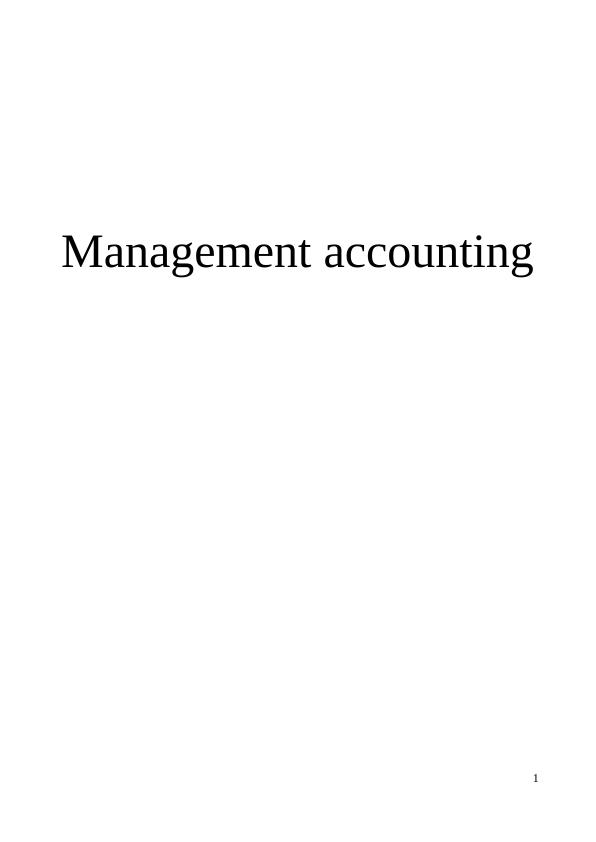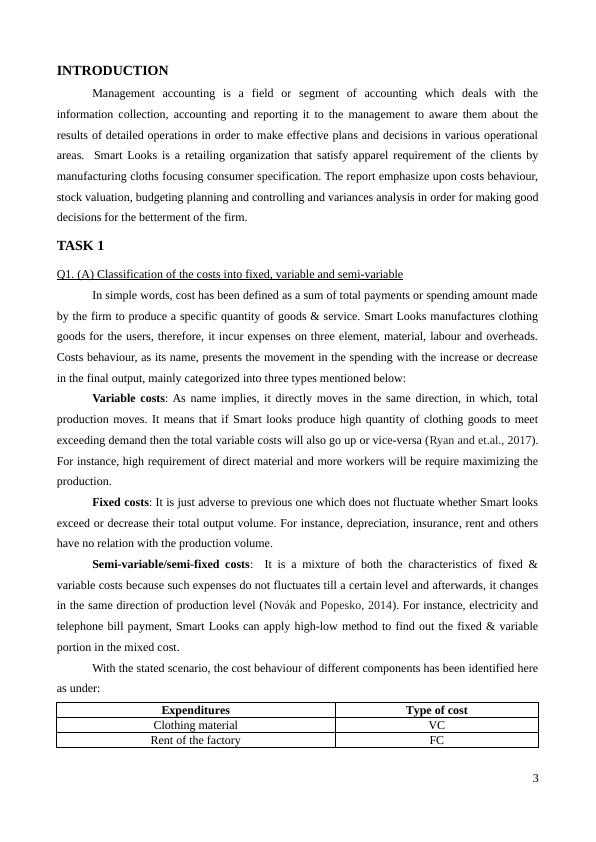Managing costs of goods sold under different inventory methods
19 Pages5696 Words316 Views
Added on 2020-02-03
About This Document
(A) Computing the total costs and unit costs for the production level 4 (B) Analyzing costs data using graphical format 5 Q3.(1) First-in-First out 6 (2) Last-in-first out 6 (3) Average costs method 7 Q4. (A) Classification of the costs into fixed, variable and semi-variable In simple words, cost has been defined as a sum of total payments or spending amount made by the firm to produce a specific quantity of goods & service.
Managing costs of goods sold under different inventory methods
Added on 2020-02-03
ShareRelated Documents
Management accounting1

Table of ContentsINTRODUCTION................................................................................................................................3TASK 1.................................................................................................................................................3Q1. (A) Classification of the costs into fixed, variable and semi-variable.......................................3(B) Explaining other ways of costs classification.............................................................................4Q2. (A) Computing the total costs and unit costs for the production level......................................4(B) Analyzing costs data using graphical format..............................................................................5Q3.(1) First-in-First out....................................................................................................................6(2) Last-in-first out...........................................................................................................................6(3) Average costs method..................................................................................................................7Q4. Preparing a report presenting costs of goods sold under different inventory methods..............7Q5. Indicators to be used for measuring the success........................................................................8(A) Two critical success factor & KPIs............................................................................................8(B)(i) Ways to minimize costs..........................................................................................................8(ii) Strategies to enhance value & quality.........................................................................................8TASK 2.................................................................................................................................................9Q6.....................................................................................................................................................9(A) Budget definition........................................................................................................................9(B) Purpose of budget.......................................................................................................................9(C) Different kind of methods for preparation of budget...............................................................10Q7....................................................................................................................................................11(A) Sales budget..............................................................................................................................11(B) Production budget.....................................................................................................................11(C) Raw material budget.................................................................................................................12(D) Labour budget..........................................................................................................................12(E) Total overheads budget.............................................................................................................12Q8. Cash budget and its analysis....................................................................................................13TASK 3...............................................................................................................................................14Q9. (A) Calculation of budgeted profit for the month of March, 2017..........................................14(B) Calculation of actual profit for the month of March, 2017......................................................14(C). Calculation of material & labour variances.............................................................................15(D). Preparation of an operating statement reconciling the targeted and actual results.................16Q10. Managerial report...................................................................................................................16CONCLUSION..................................................................................................................................17REFERENCES...................................................................................................................................182

INTRODUCTION Management accounting is a field or segment of accounting which deals with theinformation collection, accounting and reporting it to the management to aware them about theresults of detailed operations in order to make effective plans and decisions in various operationalareas. Smart Looks is a retailing organization that satisfy apparel requirement of the clients bymanufacturing cloths focusing consumer specification. The report emphasize upon costs behaviour,stock valuation, budgeting planning and controlling and variances analysis in order for making gooddecisions for the betterment of the firm. TASK 1Q1. (A) Classification of the costs into fixed, variable and semi-variableIn simple words, cost has been defined as a sum of total payments or spending amount madeby the firm to produce a specific quantity of goods & service. Smart Looks manufactures clothinggoods for the users, therefore, it incur expenses on three element, material, labour and overheads.Costs behaviour, as its name, presents the movement in the spending with the increase or decreasein the final output, mainly categorized into three types mentioned below:Variable costs: As name implies, it directly moves in the same direction, in which, totalproduction moves. It means that if Smart looks produce high quantity of clothing goods to meetexceeding demand then the total variable costs will also go up or vice-versa (Ryan and et.al., 2017).For instance, high requirement of direct material and more workers will be require maximizing theproduction. Fixed costs: It is just adverse to previous one which does not fluctuate whether Smart looksexceed or decrease their total output volume. For instance, depreciation, insurance, rent and othershave no relation with the production volume. Semi-variable/semi-fixed costs: It is a mixture of both the characteristics of fixed &variable costs because such expenses do not fluctuates till a certain level and afterwards, it changesin the same direction of production level (Novák and Popesko, 2014). For instance, electricity andtelephone bill payment, Smart Looks can apply high-low method to find out the fixed & variableportion in the mixed cost. With the stated scenario, the cost behaviour of different components has been identified hereas under:ExpendituresType of costClothing material VC Rent of the factory FC3

Factory power charged each unit of electricity VCSupervisors’ wages (Flat plus bonus)Semi-variableMaterial for packaging VCTelephone expenseSemi-variable official ratesFCPayment to driver (Flat rate plus bonus)Semi-variable HeatingFC(B) Explaining other ways of costs classificationTraceability/chargeability Direct costs: Expenses which Smart Looks can allocate & assign directly to each unitproduced is called direct costs (DRURY, 2013). For instance, fabric used to make cloth and wagesof the workers who are employed in the production process.Indirect costs: Unlike above, expenditures incurred on those items which cannot be directlychargeable to the cloth items manufactured are known as indirect cost i.e. depreciation. Functions/Activities:Production/works cost: Expenditures incurred during the manufacturing or productionprocess are called production cost like production overheads, factory heating & others. Administration cost: Sum of total payments made for administrating the business functionsare called administrative costs i.e. office stationery, staff salary, printing & other payment (Deegan,2013). Selling & distribution cost: All the efforts that are made by Smart looks to maximize theirtotal turnover are called selling & distribution cost i.e. packaging, marketing, advertisement. ExpendituresDirect and indirect costFunctions/ActivitiesClothing material DC WCRent of the factory IC WCFactory power charged each unit of electricity DC WCSupervisors’ wages (Flat plus bonus)IC WCMaterial for packaging DC Selling anddistributionTelephone expenseIC ACofficial ratesICACPayment to driver (Flat rate plus bonus)ICACHeatingICWCQ2. (A) Computing the total costs and unit costs for the production levelIn the field of cost accounting, total costs of production comprises variable costs that varyaccording to the production quantity inclusive of fixed costs which are totally independent from the4

End of preview
Want to access all the pages? Upload your documents or become a member.
Related Documents
Report on Strategic and Competent Policy Frameworklg...
|24
|5145
|60
MANAGEMENT ACCOUNTING AND COGS Reportlg...
|24
|5191
|500
Various Type of Costs of the Cited Firm | Assignmentlg...
|15
|3452
|96
MANAGEMENT ACCOUNTING TABLE OF CONTENTS INTRODUCTION 5 Q1.5 a) Classification of cost 5 Q2.7 b) Analysis of inventory 7 Q3. Method 8lg...
|18
|3165
|106
Management Accounting: Cost Analysis and Inventory Valuationlg...
|23
|4654
|63
Management Accounting Costing and Budgetinglg...
|22
|4577
|50
